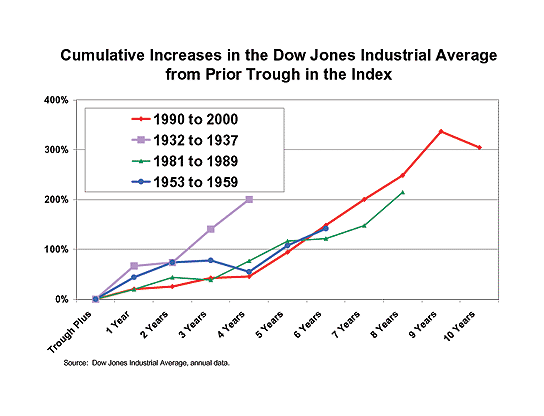NBER presents U.S. Monetary Policy During the 1990s, Matt Nesvisky's review of Greg Mankiw's review of, well, of U.S. monetary policy in the 1990s.
Mankiw notes the low volatility of inflation, growth, and joblessness. Then too, "large supply shocks were uncommon in the 1990s" , and "Good shocks in fact were more common than bad." All told, Mankiw sees in the 1990s a combination of good policy and good luck.
Here's the piece of Nesvisky's article that that gets my full attention:
Also fortuitous was the behavior of the stock market, for not only were returns high but volatility was low, making the 1990s essentially the best time ever to be investing in Wall Street. Little evidence suggests the booming market played a large, independent role in monetary policy. Yet significantly, the bull market of the period preceded the acceleration of the productivity rate by several years, and the market can be a driving force of the business cycle.
"The bull market preceded the acceleration of the productivity rate by several years."
I went right away to FRED -- it seems to be okay when calculations of series data are not involved -- for a look at Dow Jones and S&P rate-of-change rates:
 |
| Graph #1: Stock Market Index Growth Rates |
But that's not "several years" before the acceleration of the productivity rate! What was Mankiw thinking???
Dean Baker and John Schmitt describe a "nine-year 1996-2004 boom" in productivity. Bill C at Twenty-Cent Paradigms presents his own estimate and that of the Economic Report of the President; both show the boom beginning in 1996. In a 2002 paper, Robert J. Gordon refers to "The 1995-2000 productivity growth revival". These sources all place the start of the productivity boom in 1995 or '96 -- the same year or the year immediately following the 1995 date I have identified as the start of the 1990s bull market. In contrast to Mankiw's "several years".
Perhaps I have the bull market date wrong? No. The San Fransisco Fed's Dr. Econ (February 2001) offers this graph showing the bullish increase beginning in the fifth year after 1990 -- that is, in 1995:
 |
| Graph #2: The bull market of the 1990s (red) begins in1995 |
But if you're looking for something that "preceded the acceleration of the productivity rate by several years" I've got a contender for you. It's my latest version of the debt-per-dollar ratio -- base-to-debt this time. I first presented it on 23 March in relation to potential GDP. I offer it again now in contrast the the bull market story of Greg Mankiw.
 |
| Graph #3: Base Money Relative to Total Debt (red) and Stock Market Measures |
On Graph #3 you can see a tall, wide increase in base relative to total debt. It begins around 1990 and lasts into the mid-1990s. This burst of money growth (in a time of reduced debt growth) does in fact occur "several years" before the start of the stock market and productivity booms of the 1990s. In fact, the lines cross in the mid-1990s: the red base-to-debt line falling just as the market indices get a good uptrend going.
Here's the link. But FRED can't get the dates right.

1 comment:
Conclusion:
So if Mankiw is right that we should look for something that happened "several years" before the start of the productivity boom, then the thing we're seeking is not the stock market boom. But it may well be the change in the ratio of money to debt.
Post a Comment